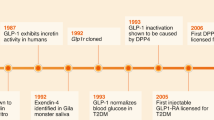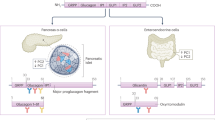Abstract
THERE is considerable experimental evidence that glucagon (hyperglycæmic factor of the pancreas) is a true hormone which originates in the α-cells of the islets of Langerhans1. Its isolation and crystallization were reported in 19532. The crystalline material appears to be a simple protein with a molecular weight of approximately 4,200 and an amino-acid content which differs significantly from that of insulin3. Minute doses of crystalline glucagon (0.1γ in the cat) cause a significant rise in blood sugar3. This effect is probably brought about by a stimulation of liver glycogenolysis, since glucagon has been shown to increase the net synthesis of liver phosphorylase4. Further than this, little is known about the action or physiological role of glucagon. Current speculation revolves about three possibilities: (a) that glucagon is an anti-insulin hormone1, (b) that it is an insulin synergist5, or (c) that it has no significant function in the control of carbohydrate metabolism6.
This is a preview of subscription content, access via your institution
Access options
Subscribe to this journal
Receive 51 print issues and online access
$199.00 per year
only $3.90 per issue
Buy this article
- Purchase on Springer Link
- Instant access to full article PDF
Prices may be subject to local taxes which are calculated during checkout
Similar content being viewed by others
References
Foa, P., “Advances in Internal Medicine”, 6, 29 (Year Book Pub. Inc., Chicago, 1954). DeDuve, C., Lancet, ii, 99 (1953).
Staub, A., Sinn, L., and Behrens, O. K., Science, 117, 628 (1953).
Staub, A., Sinn, L., and Behrens, O. K., J. Biol. Chem., 214, 619 (1955).
Sutherland, E. W., and Cori, C. F., J. Biol. Chem., 188, 531 (1951). Sutherland, E. W., Wosilait, W. D., and Ball, T., Fed. Proc., 14, 289 (1955).
Bürger, M., “Fortschritte der Diagnostik und Therapie”, Bd. 1, Heft 7 (1950).
Conn, J. W., Ann. Int. Med., 38, 179 (1953).
(a) Elrick, H., Hlad, C. J., Witten, T., J. Clin. Invest. (Dec. 1955). (b) Elrick, H., Hlad, C. J., Arai, Y., and Smith, A., J. Clin. Invest, (in the press).
Nelson, N., J. Biol. Chem., 153, 375 (1944).
Elrick, H., International Symposium, Hypophyseal Growth Hormone Nature and Actions, 561 (McGraw-Hill Book Co., Inc., 1955).
Author information
Authors and Affiliations
Rights and permissions
About this article
Cite this article
ELRICK, H. Glucagon and the Regulation of Carbohydrate Metabolism. Nature 177, 892–893 (1956). https://doi.org/10.1038/177892a0
Issue Date:
DOI: https://doi.org/10.1038/177892a0
This article is cited by
-
Glucagon als Synergist des Insulins
Die Naturwissenschaften (1966)
Comments
By submitting a comment you agree to abide by our Terms and Community Guidelines. If you find something abusive or that does not comply with our terms or guidelines please flag it as inappropriate.



